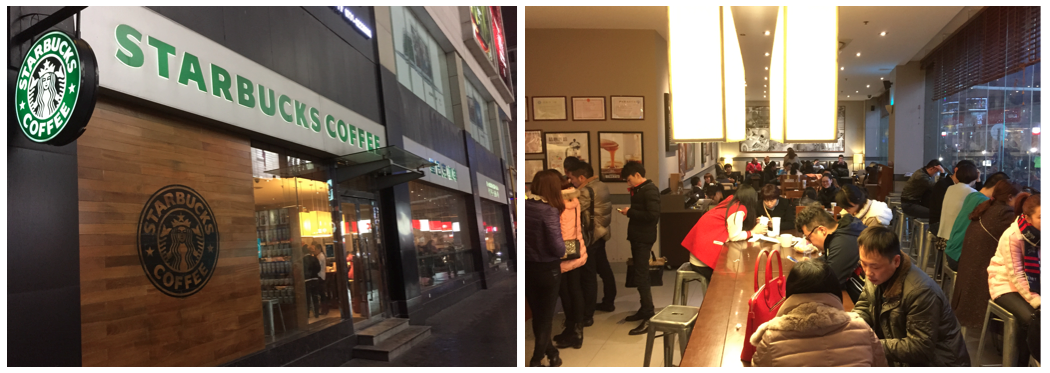Starbucks in Changsha, China: Growing Upper Middle-Income Consumers
March 20, 2015
Akira Kondo

Hunan province is famously known among Chinese as a birthplace of Mao Zedong. (L) The Xiang River will eventually connects to the Yangtze River, the longest river in Asia. (C) A young Mao statue is located at the southern tip of the island. Walking from Crowne Plaza to there may take about 90 minutes or so. (R) Crowne Plaza Changsha City Center is conveniently located in the heart of the city. Most restaurants, including Starbucks, open till late.
|
In 2011, I briefly stayed at Changsha Huanghua Airport while asking local school volunteers in English if there were any Starbucks stores in the city. The answer was no and in fact, they even did not know what Starbucks really was. By 2012, I heard from my local friend that a first Starbucks store in Changsha had opened and she had sent me a picture of it (the first Starbucks store in Changsha actually opened in 2010). Over the past couple of years, the number of Starbucks stores in Changsha increased to 17. This year, I was finally able to visit this city and the Starbucks stores while my curiosity about the inland Chinese consumers over expensive Starbucks products extended into the universe, where there were thousands of unsolved topics I wanted to uncover.
The first difference I had discovered about Starbucks in Changsha city was how easy it was to find the stores even when sitting back and relaxing in the car. Unlike Starbucks stores in the United States, most Starbucks stores in China are located in places, such as department stores and office buildings. Although they are located in the building, Starbucks sings are crystal clear that anyone can find that a green mermaid on the wall of the buildings or “STARBUCKS.” Before stepping into one of Starbucks stores in Changsha, I had surely expected a quieter store to enjoy my favorite Starbucks moment by sitting back, relaxing, and enjoying reading a book, Thomas Piketty’s “Capital in the Twenty-First Century.” However, the store turned out to be very noisy and crowded while many couples and groups of young people occupied any available tables in the store even at 10pm! In China, some downtown Starbucks stores open till closer to 12 midnight. Probably it is one of the many reasons that Starbucks in China is very profitable. As always, young Chinese people like to order more expensive Venti- or Grande-sized drinks because they want to show off to each other that they have the biggest ones on a table but still some rational customers just like to consume a large amount of drink to treat themselves after stressful work. This Changsha Starbucks store is truly like the Chinese people’s third place, where the company is willing to offer. Those young Chinese want to enjoy chatting with friends in an air-conditioned spacious and modern room rather than being at home. I know that they drink only tea at home without any ifs, ands or buts, but it does not mean they dislike coffee at Starbucks. However, they do not drink plain coffee or Americano, rather they choose to drink sweeter Mocha, Latte, and icy Frappuccino. |
|
|
Chinese tastes are different. A few years ago, I had an opportunity to take a survey about coffee in China at one of leading American tech companies in Shanghai, where there were many young middle-income level employees, who could afford to buy expensive Starbucks products and most importantly knew Starbucks. The survey result confirmed that the most people preferred tea to coffee and what they generally ordered the most at Starbucks were sweeter Frappuccino. In inland China, tea culture should yield much higher while wishing that I could take the same survey there as well. When I was in the store in Changsha, I could hear many customers ordering hot green tea latte, never heard of plain coffee or Americano at that time.
A tall-sized Green Tea Frappuccino costs 30RMB or about US$4.85 in China (exchange rate as of March 19, 2015), which is more expensive than that in the United States. According to PPP-based (Purchasing Power Parity) Big Mac Index issued by The Economist in January 2015, Chinese currency RMB is undervalued by 42 percent. However, Starbucks’ products are not undervalued at all. That 30RMB for the Frappuccino can purchase nearly two BigMac sandwiches (17RMB each) at McDonald’s, which is located just right next to that Starbucks store. Hence, Starbucks’ ability as well as popularity is enough to attract growing upper middle-income Chinese consumers even in inland. Yet, 30RMB is still not cheap at all for most local Shanghsha consumers. In fact, even foreign travelers feel the same that Starbucks’ products in China are not inexpensive. |
Related Articles |

(L) McDonald’s at night. Despite the weekend night, the store seems quieter than Starbucks. (C) McDonald’s products are relatively undervalued compared to those in the U.S. This advertisement offers a double Filet-O-Fish sandwich (or a double cheese or a double McChicken) with a medium cup of soda costs only 15RMB. (R) Thomas Piketty’s “Capital in the Twenty-First Century” at Loudi train station, which will soon extend to Shaoyang. The high-speed train now runs from Shanghai to this station while income gaps between those places are much higher.


